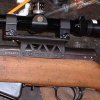Matt Dillon
Member
Folks, I have finally purchased a Choate scope mount, after trying several different type of receiver cover mounts(and wasting a ton of good ammo in vain).
This is the first gun that I will attempt to drill and tap myself (I have paid a gunsmith in the past, but the budget won't allow it these days).
I have purchased the drill and taps from MidwayUSA, and had a couple of questions while I wait for the Choate mount to come in.
I was wondering, how do you accurately mark the holes in order to center punch them? I have read the article from surplusrifle.com, and he reccomends clamping the choate mount to the rifle while drilling the holes. I was wondering, how do you accurately center punch the starting hole through the choate mount? Is there some type of bushing to use, to get the center punch centered in the scope mount holes?
After I successfully drill the holes, should I place the tap into the drill press chuck (Delta Radial drill press), in order to start the tap square to the receiver? If I do that, how do I turn the tap to start it in the hole?
How hard is the SKS receiver? I will be mounting the Choate mount on to a 59/66 Yugoslavian SKS.
Any advice and help regarding mounting this scope mount will be greatly appreciated, thanks so much in advance!
This is the first gun that I will attempt to drill and tap myself (I have paid a gunsmith in the past, but the budget won't allow it these days).
I have purchased the drill and taps from MidwayUSA, and had a couple of questions while I wait for the Choate mount to come in.
I was wondering, how do you accurately mark the holes in order to center punch them? I have read the article from surplusrifle.com, and he reccomends clamping the choate mount to the rifle while drilling the holes. I was wondering, how do you accurately center punch the starting hole through the choate mount? Is there some type of bushing to use, to get the center punch centered in the scope mount holes?
After I successfully drill the holes, should I place the tap into the drill press chuck (Delta Radial drill press), in order to start the tap square to the receiver? If I do that, how do I turn the tap to start it in the hole?
How hard is the SKS receiver? I will be mounting the Choate mount on to a 59/66 Yugoslavian SKS.
Any advice and help regarding mounting this scope mount will be greatly appreciated, thanks so much in advance!


